
The Fishy Story of Riverside Park's North End
Written by Anita Taylor Doering, Archives staff
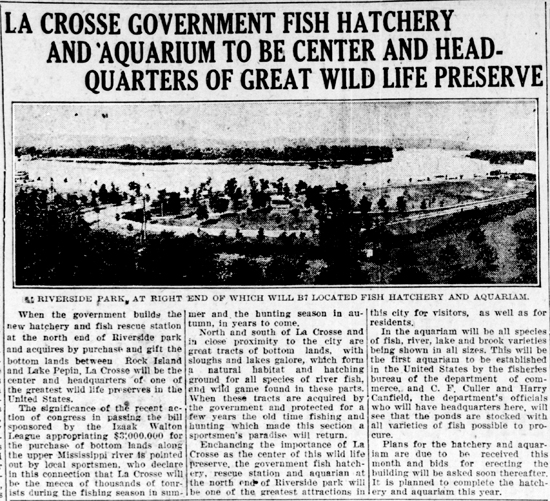
La Crosse Tribune, June 27, 1924, page 34
Many local conservationists and fishermen lobbied the federal government to locate a fish hatchery and rescue station in La Crosse before the United States became involved in World War I. Because of agricultural development and increased numbers of people commercially and recreationally fishing the Mississippi River, the quality of fishing had significantly declined. This effort, with lobbying from the Izaak Walton League, eventually resulted in the creation of the Upper Mississippi River Wildlife Refuge.
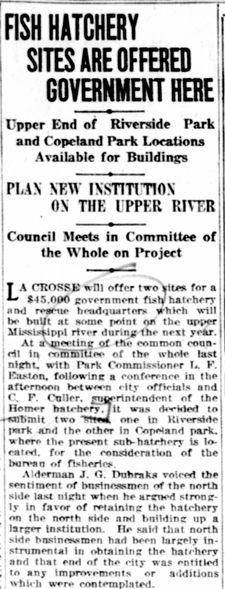
La Crosse Tribune, Sept. 9, 1919, page 1
But by the fall of 1919, the Bureau of Fisheries committed funds to the project and was ready to finally move the headquarters from Homer, Minnesota [known as the Winona station], to La Crosse. The Board of Park Commissioners was approached about the feasibility of providing ground at the north end of Riverside Park as a location for a fish hatchery building to be built by the U. S. government, and the Park Board was amenable. A news story from that same day reported that La Crosse “will offer two sites for a $45,000 government fish hatchery and rescue headquarters which will be built at some point on the upper Mississippi river during the next year.” The north end of Copeland Park was already in use at that time as a fish rescue station, and the North Side businessmen argued strongly through their Council representative J. G. Dubraks that the hatchery should be located there.
However, Clarence F. Culler, superintendent of the fish hatchery, approved the Riverside Park site, favoring the location at the confluence of the Black, La Crosse and Mississippi rivers, where the water at this point “met every requirement for fish propagation purposes” and shipping facilities were close at hand. Culler also commented to Mayor Bentley that the North Side site would not be considered because of the difficulties in navigating the stream in low water.

La Crosse Tribune, January 24, 1923, page 1
By November 1922, the Park Board was reviewing the plans for the station that included an aquarium on the west side and the fish rescue station on the east side along with a garage and by the following January, Riverside became the official selection for a site. Once approved locally, the plans then were forwarded to Washington.

The fish hatchery building closer to its original appearance.
The bid of local contractor Charles W. Noble was selected, and the building was completed by May 1925. The buildings were constructed of hollow tile and cement construction. The aquarium was the only one of its kind up to that time built by the U. S. Bureau of Fisheries, and every variety of river fish was on display. The aquarium formally opened Sept. 7, 1925, and the building was open to the public everyday from that point forward. Formal dedicatory services were held with band concerts, a parade, speeches and an open house of the facilities on Oct. 22, 1925. The new fish hatchery was said to be the best equipped hatchery in the nation, according to C. F. Culler, district supervisor of the Bureau of Fisheries.
Two Craftsmen style residences were constructed in 1929 by the U. S. government to house the U. S. Fisheries district supervisor and superintendent and their families at 2319 and 2323 Madison Street. These properties were sold as surplus property in 1967 to the Board of Regents as temporary housing for La Crosse Sate University faculty and guest housing.
In 1959 the focus of the hatchery changed to controlling fish by encouraging game fish propagation and discouraging reproduction of exotics and “rough” fish by using controlled experiments with chemistry and electricity. It was then called the Fish Control Laboratory and was dedicated as such in 1962.
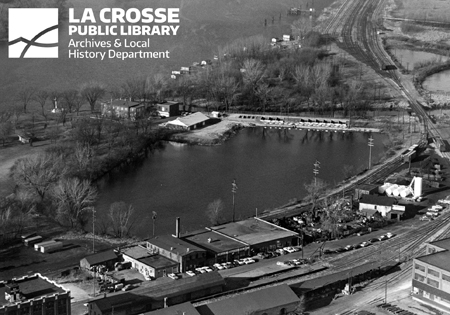
An aerial view of the hatchery building and its outbuildings looking northwest; the large bass pond can clearly be seen in the foreground.

An aerial view of the hatchery building and its outbuildings looking east; the fish ponds can clearly be seen in this view.
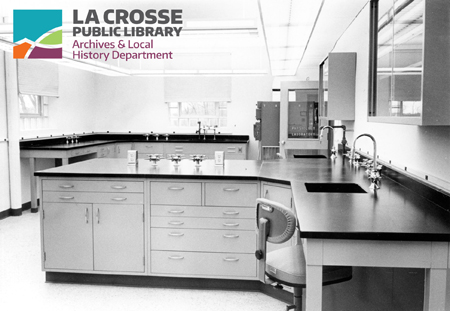
A photo of the laboratory when it reopened as the "Fish Control Lab," circa 1962.
This group moved to new quarters on French Island in September 1978, and already the city, through the Park Board, had made a deal with the La Crosse Convention and Visitors Bureau to lease space in the former fisheries building. Part of that plan was to have a museum element on the first floor to be called the Museum of Science and Industry, and offices for the Bureau on the second.

The former fish hatchery and laboratory, circa late 1960s/early 1970s.
In September 1981, the building was included in the National Register of Historic Places because of “its critical role in the conservation of food fish populations as the nation’s center of research for control of the lamprey eel as well as its longer-term role in the maintenance of fish and mussel populations in certain inland waters of the United States.” The fish ponds were sold and filled in by 1981.
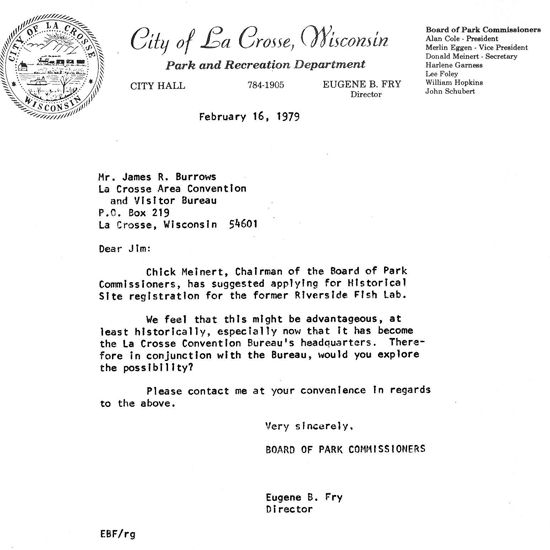
Letter from the Board of Park Commissioners via Eugene Fry to James "Jim" Burrows, head of the La Crosse Area Convention and Visitors' Bureau, February 16, 1979. Part of La Crosse Series 13, La Crosse Public Library Archives
At the time of the National Historic Register submission, the goal of the Convention and Visitors Bureau was to use the building as a river center depicting the history of La Crosse and the role of the Mississippi River in its development.
By 1990, it was clear that the Riverside USA lacked the funds and professional staff needed to successfully interpret, educate, and properly care for historical artifacts. The La Crosse County Historical Society agreed to take on the management of the museum with a $4959 grant from the La Crosse Community Foundation. The museum reopened June 22, 1990, with a focus on educating the public and tourists to the relationship of the river with the city. Sometime in this era, the Mississippi Valley Archaeology Center joined in as a partner to help tell the story of the Native Peoples in the La Crosse area. In 2004, the La Crosse County Historical Society updated the museum to the tune of $7,000 and began requiring admission from the roughly 12,000 visitors a year.
The city’s Park and Recreation Department wanted to change direction for the former Fish Hatchery building and the lease for the use of the building expired for both the Convention and Visitor’s Bureau and the museum. The Riverside museum officially closed for good on December 31, 2019, and the remaining artifacts were removed by mid-February 2020. The La Crosse County Historical Society opened a new La Crosse Area Heritage Center in downtown La Crosse at 506 Main Street in November 2020 that incorporated many of the same historical themes with new displays and interpretation, better lighting and more environmentally friendly air handling for historical objects.
The La Crosse County Convention and Visitors Bureau also vacated the building and moved to new quarters circa 2020 at 123 7th St South in downtown La Crosse, leaving the city to decide what to do with the former Fish Hatchery building on the north end of Riverside Park.
